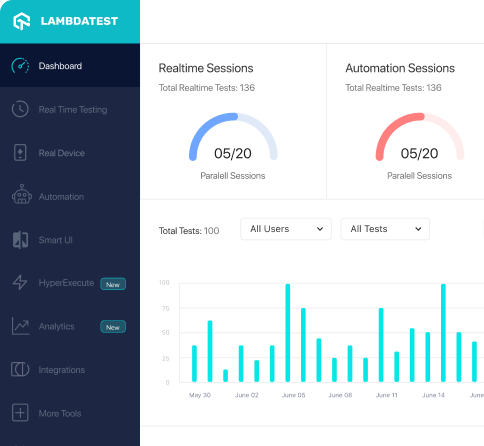How to use MultiGetBeanStep2 class of org.fluentlenium.adapter.cucumber.integration.tests.io.cucumber.multiinheritance.steps package
Best FluentLenium code snippet using org.fluentlenium.adapter.cucumber.integration.tests.io.cucumber.multiinheritance.steps.MultiGetBeanStep2
Source:MultiGetBeanStep2.java
...4import org.fluentlenium.adapter.cucumber.FluentCucumberTest;5import org.fluentlenium.adapter.cucumber.integration.page.LocalPage;6import org.fluentlenium.adapter.cucumber.integration.page.LocalPage2;7import org.fluentlenium.core.annotation.Page;8public class MultiGetBeanStep2 extends FluentCucumberTest {9 @Page10 protected LocalPage page;11 @Page12 protected LocalPage2 page2;13 @When(value = "scenario multi2 I click on next page")14 public void step2() {15 page.clickLink();16 }17 @Then(value = "scenario multi2 I am on the second page")18 public void step3() {19 page2.isAt();20 }21}...MultiGetBeanStep2
Using AI Code Generation
1 at org.fluentlenium.adapter.cucumber.integration.tests.io.cucumber.multiinheritance.steps.MultiGetBeanStep2.<init>(MultiGetBeanStep2.java:9)2 at sun.reflect.NativeConstructorAccessorImpl.newInstance0(Native Method)3 at sun.reflect.NativeConstructorAccessorImpl.newInstance(NativeConstructorAccessorImpl.java:62)4 at sun.reflect.DelegatingConstructorAccessorImpl.newInstance(DelegatingConstructorAccessorImpl.java:45)5 at java.lang.reflect.Constructor.newInstance(Constructor.java:423)6 at cucumber.runtime.Utils$1.call(Utils.java:37)7 at cucumber.runtime.Timeout.timeout(Timeout.java:16)8 at cucumber.runtime.Utils.newInstance(Utils.java:31)9 at cucumber.runtime.java.JavaStepDefinition.execute(JavaStepDefinition.java:38)10 at cucumber.runtime.StepDefinitionMatch.runStep(StepDefinitionMatch.java:37)11 at cucumber.api.TestStep.executeStep(TestStep.java:102)12 at cucumber.api.TestStep.run(TestStep.java:83)13 at cucumber.api.TestCase.run(TestCase.java:58)14 at cucumber.runner.Runner.runPickle(Runner.java:50)15 at cucumber.runtime.junit.PickleRunners$NoStepDescriptions.run(PickleRunners.java:149)16 at cucumber.runtime.junit.FeatureRunner.runChild(FeatureRunner.java:68)17 at cucumber.runtime.junit.FeatureRunner.runChild(FeatureRunner.java:23)18 at org.junit.runners.ParentRunner$3.run(ParentRunner.java:290)19 at org.junit.runners.ParentRunner$1.schedule(ParentRunner.java:71)20 at org.junit.runners.ParentRunner.runChildren(ParentRunner.java:288)21 at org.junit.runners.ParentRunner.access$000(ParentRunner.java:58)22 at org.junit.runners.ParentRunner$2.evaluate(ParentRunner.java:268)23 at org.junit.runners.ParentRunner.run(ParentBlogs
Check out the latest blogs from LambdaTest on this topic:
API (Application Programming Interface) is a set of definitions and protocols for building and integrating applications. It’s occasionally referred to as a contract between an information provider and an information user establishing the content required from the consumer and the content needed by the producer.
Collecting and examining data from multiple sources can be a tedious process. The digital world is constantly evolving. To stay competitive in this fast-paced environment, businesses must frequently test their products and services. While it’s easy to collect raw data from multiple sources, it’s far more complex to interpret it properly.
Entering the world of testers, one question started to formulate in my mind: “what is the reason that bugs happen?”.
I routinely come across test strategy documents when working with customers. They are lengthy—100 pages or more—and packed with monotonous text that is routinely reused from one project to another. Yawn once more— the test halt and resume circumstances, the defect management procedure, entrance and exit criteria, unnecessary generic risks, and in fact, one often-used model replicates the requirements of textbook testing, from stress to systems integration.
Automation Testing Tutorials
Learn to execute automation testing from scratch with LambdaTest Learning Hub. Right from setting up the prerequisites to run your first automation test, to following best practices and diving deeper into advanced test scenarios. LambdaTest Learning Hubs compile a list of step-by-step guides to help you be proficient with different test automation frameworks i.e. Selenium, Cypress, TestNG etc.
LambdaTest Learning Hubs:
- JUnit Tutorial
- TestNG Tutorial
- Webdriver Tutorial
- WebDriverIO Tutorial
- Protractor Tutorial
- Selenium 4 Tutorial
- Jenkins Tutorial
- NUnit Tutorial
- Jest Tutorial
- Playwright Tutorial
- Cypress Tutorial
- PyTest Tutorial
YouTube
You could also refer to video tutorials over LambdaTest YouTube channel to get step by step demonstration from industry experts.
Try LambdaTest Now !!
Get 100 minutes of automation test minutes FREE!!



